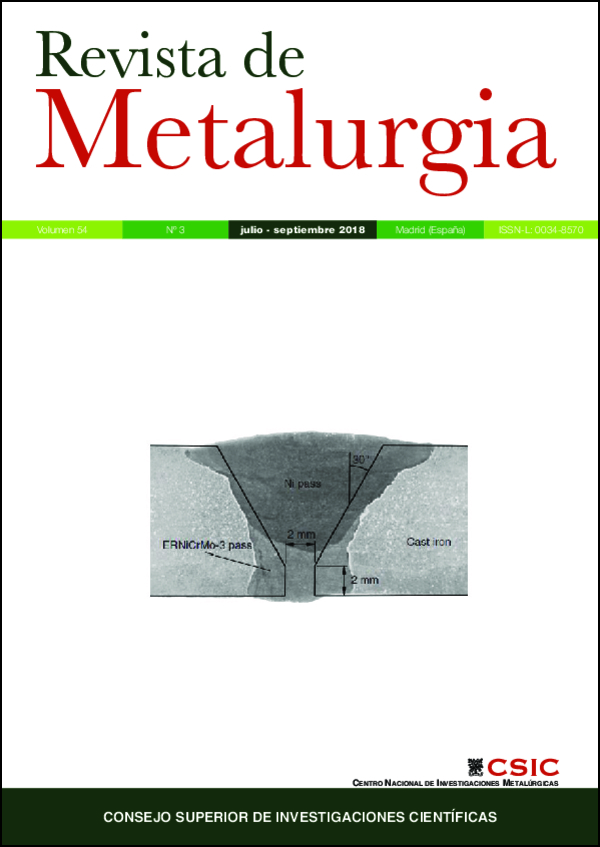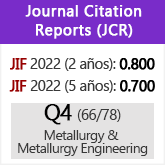Evolución y proceso de fabricación de imanes “NEO” aplicados a motores de vehículos eléctricos
DOI:
https://doi.org/10.3989/revmetalm.127Palabras clave:
Aglomerado, Imanes permanentes, Sinterizado, Tierras rarasResumen
Tras el desarrollo de los imanes Nd-Fe-B o “Neo”, éstos son ahora componentes esenciales en muchos campos de la tecnología debido a su capacidad para proporcionar un fuerte flujo magnético. Existen dos técnicas bien establecidas para la fabricación de imanes de tierras raras: a) el uso de la metalurgia de polvo para obtener cuerpos magnéticos de alto rendimiento, anisotrópicos, totalmente densos; y b) el proceso de hilado por fusión o HDDR (hidrogenación, decrepitación, desorción y recombinación) se usa ampliamente para producir polvos magnéticos para imanes aglomerados. En la industria de los imanes de Nd-Fe-B sinterizados, la producción total ha aumentado y su aplicación dominante es principalmente motores y en particular, su uso para automóviles híbridos es una de las aplicaciones más atractivas. También se han utilizado imanes aglomerados para motores pequeños, los estudios de nanocompuestos y de imanes Sm-Fe-N se han generalizado. Este artículo revisa el estado actual y las tendencias futuras en la investigación de imanes permanentes.
Descargas
Citas
Abad, V., Sagredo, J. (2018). Imanes permanentes de tierras raras. El nuevo oro negro de los vehículos eléctricos. Revista DYNA 93 (1), 47–51.
Aichi Steel Company (2012). MAGFINE Technical Datasheet. Disponible Web 10/07/2018: https://www.aichi-steel.co.jp/ ENGLISH/products/electromagnetic/bonded_magnet/ item/magfine_datasheet-201705.pdf.
Anderson, I.E., McCallum, R.W., Kramer, M.J. (2003). Development of improved Podwer for Bonded Permanent Magnets. IEEE International Magnetics Conference (INTERMAG), Boston, USA.
Anderson, I.A. (2012a). Permanent Magnet Development for Automotive Traction Motors. Hydrogen and Fuel Cells Program and Vehicle Technologies. AMES Laboratories. Disponible Web 10/07/2018: https://www.energy.gov/sites/ prod/files/2014/03/f10/ape015_anderson_2012_o.pdf.
Anderson, I.A. (2012b). Accomplishments in Rare Earth Anisotropic (R2Fe14B-type) Magnet Research. FY 2011 Progress Report. A.P.E. a. E. Motors. Disponible Web 10/07/2018: https://www.energy.gov/sites/prod/files/2014/03/f8/2011_ apeem_report.pdf.
Boldea, I., Tutelea, L.N., Parsa, L., Dorrell, D. (2014). Automotive Electric Propulsion Systems with Reduced or No Permanent Magnets: An Overview. IEEE T. Ind. Electron. 61 (10), 5696–5711. https://doi.org/10.1109/TIE.2014.2301754
Brown, D.N., Na, B.-M., Campbell, P. (2002). The comparison of anisotropic (and isotropic) powders for polymer bonded Rare-Earth permanent magnets. International Workshop; 17th, Rare-Earth Magnets and their Applications, Newark, USA, pp. 62–73.
Constantinides, S. (2010). The Magnetic Material Challenge. ARPA-E Workshop Rare Earth and Critical Materials. Arlington, VA. Disponible Web 10/07/2018: https://www. yumpu.com/en/document/view/37661052/the-magnetic-material-challenge-arnold-magnetic-technologies.
DOE (2011). Critical materials Strategy. Department of Energy USA. DOE/PI/0009. https://www.energy.gov/sites/prod/ files/DOE_CMS2011_FINAL_Full.pdf.
Deshpande, U.S. (2003). Recent advances in materials for use in permanent magnet machines-a review. IEEE International Electric Machines and Drives Conference, IEMDC'03, Vol 1, pp. 509–515. https://doi.org/10.1109/IEMDC.2003.1211311
Emagnets UK (2017). Temperature effects on alnico magnets. Disponible Web 10/07/2018: http://e-magnetsuk.com/alnico_ magnets/temperature_ratings.aspx.
Fessler, R. (2011). Final Report on Assessment of Motor Technologies for Traction Drives of Hybrid and Electric Vehicles. Oak Ridge National Laboratory. Disponible Web 10/07/2018: https://info.ornl.gov/sites/publications/files/ pub28840.pdf.
Grieb, B., Brown, D., Miller, D., Shet, N. (2009). Cost effective motor design, Based on: Isotropic and Anisotropic bonded NdFeB magnets. Magnequench, Leading Magnet Innovation. Magnetic Materials in Electrical Machine Applications, Pori, Finlandia. Disponible Web 10/07/2018: http://www.prizz.fi/sites/default/files/tiedostot/linkki2ID416.pdf.
Gutfleisch, O., Willard, M.A., Brück, E., Chen, C.H., Sankar, S.G., Liu, J.P. (2011). Magnetic materials and devices for the 21st century: stronger, lighter, and more energy efficient. Adv. Mater. 23 (7), 821–842. https://doi.org/10.1002/adma.201002180 PMid:21294168
Honkura, Y. (2013). The development of Dy free MAGFINE and its applications to Motors. Symposium on "Current Research Trends in Magnetic Materials". http://komag. org/2013winter/Yoshinobu%20Honkura.pdf.
Keisan, O. (2016). Electric Machines Design Review. Power Lab at Middle East Technical University, Turkey. Disponible Web 10/07/2018: http://keysan.me/presentations/ee361_ magnets.html#14.
Liu, J. (2010). Rare Earth Magnet Design Considerations. ARPA-E Workshop Rare Earth and Critical Materials, Arlington, USA. Disponible Web 10/07/2018: https://www. arpa-e.energy.gov/sites/default/files/documents/files/Breakout_Session_Magnetics_LowRes.pdf
McCallum, R.W. (2012). Replacing critical rare earth materials in high energy density magnets. Bulletin of the American Physical Society 57 (1), APS Meeting 2012, Boston, Massachusetts. Disponible Web 10/07/2018: http://meetings.aps. org/Meeting/MAR12/Event/165012.
Salazar, D., Martín-Cid, A., Madugundo, R., Garitaonandia. J.S., Barandiaran, J.M., Hadjipanayis, G.C. (2016). Effect of Nb and Cu on the crystallization behavior of under-stoichiometric Nd–Fe–B alloys. J. Phys. D Appl. Phys. 50 (1), 015305. https://doi.org/10.1088/1361-6463/50/1/015305
Sugimoto, S. (2011). Current status and recent topics of rare-earth permanent magnets. J. Phys. D Appl. Phys. 44 (6), 064001. https://doi.org/10.1088/0022-3727/44/6/064001
Sokolowski, P.K. (2007). Processing and protection of rare earth permanent magnet particulate for bonded magnet applications. Thesis, Master of Science, Iowa State University.
Trout, S. (2015). Permanent Magnets 101. Disponible Web 10/07/2018: https://www.slideshare.net/StanTrout/permanentmagnets 101troutbrief.
Vaimann, T., Kallate, A., Kilk, A., Belahcen, A. (2013). Magnetic properties of reduced Dy NdFeB permanent magnets and their usage in electrical machines. Proceedings Conference Africon 2013, pp. 1–5. https://doi.org/10.1109/AFRCON.2013.6757787
Yang, Y., Walton, A., Sheridan, R., Güth, K., Gauß, R., Gutfleisch, O., Buchert, M., Steenari, B.-M., Van Gerven, T., Jones, P.T., Binnemans, K. (2017). REE Recovery from End-of-Life NdFeB Permanent Magnet Scrap: A Critical Review. J. Sustain. Metall. 3 (1), 122–149. https://doi.org/10.1007/s40831-016-0090-4
Zhao, L., Yu, H., Guo, W., Zhang, J., Zhang, Z., Hussain, M., Liu, Z., Greneche, J.M. (2017). Phase and hyperfine structures of melt-spun nanocrystalline (Ce1-xNdx) 16Fe78B6 alloys. IEEE T. Mag. 53 (11), 1800205.
Zhang, S., Xu, J., Junak, J., Fiederling, D., Sawczuk, G., Koch, M., Schalja, A., Podack, M., Baumgartner, J. (2012). Permanent magnet technology for electric motors in automotive applications. 2nd International Electric Drives Production Conference (EDPC), Nuremberg, Germany. https://doi.org/10.1109/EDPC.2012.6425118
Publicado
Cómo citar
Número
Sección
Licencia
Derechos de autor 2018 Consejo Superior de Investigaciones Científicas (CSIC)

Esta obra está bajo una licencia internacional Creative Commons Atribución 4.0.
© CSIC. Los originales publicados en las ediciones impresa y electrónica de esta Revista son propiedad del Consejo Superior de Investigaciones Científicas, siendo necesario citar la procedencia en cualquier reproducción parcial o total.Salvo indicación contraria, todos los contenidos de la edición electrónica se distribuyen bajo una licencia de uso y distribución “Creative Commons Reconocimiento 4.0 Internacional ” (CC BY 4.0). Puede consultar desde aquí la versión informativa y el texto legal de la licencia. Esta circunstancia ha de hacerse constar expresamente de esta forma cuando sea necesario.
No se autoriza el depósito en repositorios, páginas web personales o similares de cualquier otra versión distinta a la publicada por el editor.


















